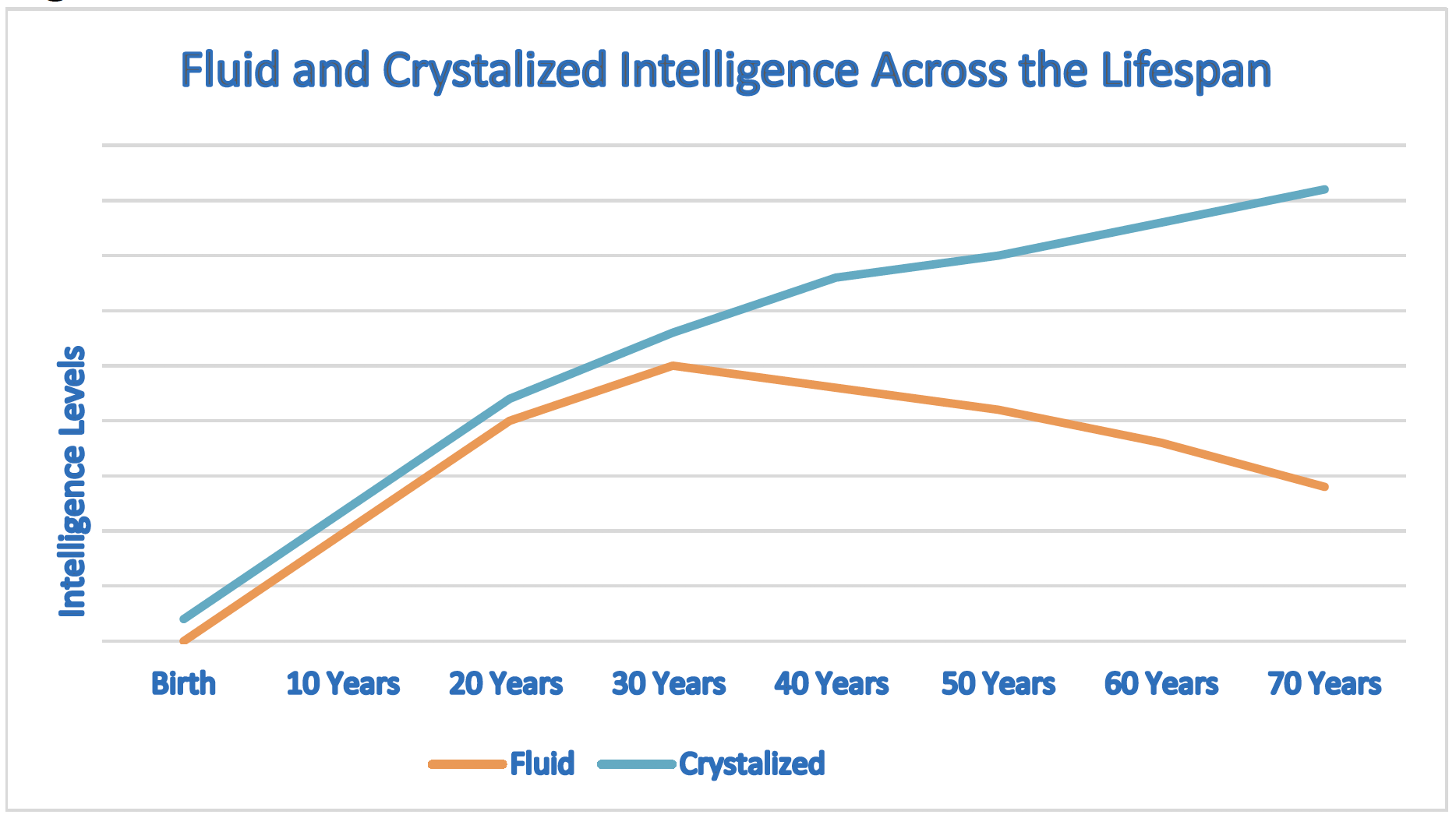On This Page:
Fluid intelligence refers to the ability to reason and solve novel problems, independent of any knowledge from the past. It involves the capacity to identify patterns, solve puzzles, and use abstract reasoning.
On the other hand, crystallized intelligence refers to the ability to use knowledge, facts, and experience that one has accumulated over time. It includes vocabulary, general world knowledge, and the application of learned information.
Key Takeaways
- Our general intelligence, which enables us to learn and recall, comprises our fluid intelligence and crystallized intelligence.
- Fluid intelligence involves comprehension, reasoning, and problem-solving, while crystallized intelligence involves recalling stored knowledge and past experiences.
- Fluid intelligence and crystallized intelligence rely on distinct brain systems despite their interrelationship in the performance of many tasks.
- Various tools are used to measure fluid and crystallized intelligence, and new research suggests that fluid intelligence can be improved, although it was hitherto supposed to be static.

Our capacity to learn the novel and recall the past is called general intelligence (Cattell, 1963). It is a construct of psychometric investigations of human intelligence and our cognitive abilities.
General intelligence encapsulates correlations among various cognitive tasks which can be categorized into two subdivisions (Cattell, 1971). These are fluid intelligence and crystallized intelligence.
The theory of fluid v. crystallized intelligence simultaneously challenges and extends what was once supposedly the single construct of general intelligence.
Cattell’s Theory of Intelligence
The theory of fluid v. crystallized intelligence was first postulated as a psychometrically based theory by psychologist Raymond B. Cattell in 1963.
Cattell argued that fluid intelligence and crystallized intelligence are two categories of general intelligence.
In his book Intelligence, Its Structure, Growth, and Action, Cattell identified one component of general intelligence as embodying a fluid quality and being directable to any problem (Cattell, 1987).
He proceeded to identify the other component as a part invested in the areas of crystalized skills. He pointed out that the latter involves knowledge acquisition and crystallized skills, which can be upset individually without impacting others.
The two concepts of fluid intelligence and crystallized intelligence were further developed by Cattell’s former student and cognitive psychologist John Leonard Horn (Horn & Cattell, 1967).
Fluid Intelligence
Fluid intelligence is the capacity to think speedily and reason flexibly to solve new problems without relying on past experience and accumulated knowledge.
Fluid intelligence allows us to perceive and draw inferences about relationships among variables and to conceptualize abstract information, which aids problem-solving. It is correlated with essential skills such as comprehension and learning.
As Raymond Cattell (1967) pointed out, it is a capacity to “perceive relationships independent of previous specific practice or instruction related to those relationships”.
Examples of the use of fluid intelligence include solving puzzles, constructing strategies to deal with new problems, seeing patterns in statistical data, and engaging in speculative philosophical reasoning (Unsworth, Fukuda, Awh & Vogel, 2014).
Horn (1969) pointed out that fluid intelligence is formless and relies only minimally upon acculturation and prior learning, which includes both formal and informal education.
He further contended that fluid intelligence is capable of flowing into a myriad of diverse cognitive activities. Consequently, the ability to solve abstract problems and engage in figural analyses and classifications, Horn argued, is dependent upon one’s level of fluid intelligence (Horn, 1968).
Fluid intelligence has long been thought to peak during the late 20s before beginning to decline (Cacioppo & Freberg 2012) gradually.
The decline of fluid intelligence is likely to be related to the deterioration of neurological functioning but may also decline as it is used less frequently during older age.

This decline of fluid intelligence has been attributed to the brain’s local atrophy in the right cerebellum, age-related changes in the brain, and a want of training (Cavanaugh & Blanchard-Fields, 2006).
Recent research, however, challenges previous assumptions and suggests that certain parts of fluid intelligence may not peak until even age 40.
Measurements of Fluid Intelligence
Woodcock-Johnson Tests of Cognitive Abilities
The Third Edition of Woodcock-Johnson Tests of Cognitive Abilities comprises concept formation, which involves categorical thinking, and analysis synthesis, which involves sequential reasoning (Woodcock, McGrew & Mather, 2001).
Concept formation herein requires the inference of underlying rules to solve puzzles presented in ascending order of difficulty (Schrank & Flanagan 2003).
Analysis synthesis, on the other hand, requires the learning and the oral presentation of solutions to logic puzzles which emulate a mathematics system. The association of procedural learning with muscle memory can make certain actions second nature (Bullemer, Nissen, & Willingham, 1989).
Raven’s Progressive Matrices
Raven’s Progressive Matrices evaluate the capacity to discern relationships among various mental representations (Raven, Raven & Court 2003).
It is a non-verbal multiple-choice test that requires the completion of several drawings based on the test takers’ ability to notice pertinent features based on the spatial positioning of several objects (Ferrer, O”Hare & Bunge 2009).
Wechsler Intelligence Scales for Children
The Wechsler Intelligence Scales for Children, Fourth Edition, relies exclusively on visual stimuli and is a non-verbal test that consists of a matrix reasoning test and a picture concept assessment (Wechsler, 2003).
The picture concept task evaluates a child’s capacity to discern the underlying traits governing a set of materials while the matrix reasoning test assesses the child’s ability to begin with stated governing traits/rules to identify the solution to a novel problem (Flanagan & Kaufman, 2004).
The solution herein is the picture for a puzzle that fits the stated rule.
What Is Crystallized Intelligence?
Crystallized Intelligence refers to the ability to utilize skills and knowledge acquired via prior learning (Horn, 1969). The use of crystallized intelligence involves the recalling of pre-existing information as well as skills.
Examples of the use of Crystallized Intelligence, on the other hand, include recalling historical events and dates, remembering geographical locations, building one’s vocabulary, and reciting poetic texts (Horn, 1968).
Crystallized Intelligence results from accumulated knowledge, including knowledge of how to reason, language skills and an understanding of technology. This type of intelligence is linked to eduction, experience and cultural background and is measured by tests of general information.
The use of crystallized intelligence involves the recalling of pre-existing information as well as skills. For example, knowing how to ride a bike or read a book.
Horn (1969) explained that Crystallized Intelligence is a “precipitate out of experience” which stems from a prior application of fluid intelligence.
Effectively completing tasks involving language mechanics (such as vocabulary building) and general information relies on one’s Crystallized Intelligence.
Crystallized Intelligence rises gradually and remains stable throughout adulthood until it begins to decline after age 60 (Cavanaugh & Blanchard-Fields, 2006).
Despite the observance of this general trend, the age at which Crystallized Intelligence reaches its peak is yet to be ascertained (Desjardins, Warnke & Jonas, 2012).
Measurements of Crystallized Intelligence
The C-Test
The C-Test is a text completion test initially proposed as a foreign language proficiency test that provides an integrative measure of crystallized intelligence (Baghaei & Tabatabaee-Yazdi, 2015).
The underlying construct of the C-Test corresponds to the abilities undergirding the language component of crystallized intelligence.
However, research implies that the careful selection of texts from relevant domains of knowledge can enable the C-Test to measure the factual knowledge component of crystallized intelligence as well.
The Wechsler Adult Intelligence Scale (WAIS)
The revised form of the Wechsler Adult Intelligence Scale, which has been used since 1981, comprises five performance and six verbal subtests (Kaufman & Lichtenberger 2006).
These verbal tests include comprehension, information, digit span, vocabulary, similarities, and arithmetic (Wechsler Adult Intelligence Scale-Revised). Most of these verbal tests are widely construed as capable of measuring crystallized intelligence.
How the Intelligence Types Work Together
While fluid intelligence and Crystallized Intelligence are distinct, it is important to note the multiplicity of the tasks that involve both these components. For instance, in taking a math exam, one may rely on one’s fluid intelligence to construct a strategy to respond to the given questions within the allocated time.
However, at the same time, one might have to utilize one’s Crystallized Intelligence to recall various mathematical concepts and theories in providing the correct answers.
Likewise, an entrepreneur might have to use her fluid intelligence to identify a new opportunity in the market. However, creating a product to meet consumer demand might require past knowledge and, therefore, the use of her Crystallized Intelligence.
Despite this manifest interrelationship, Crystallized Intelligence is not a type of fluid intelligence that has crystalized over time (Cherry, 2018). However, the investment of fluid intelligence via the learning of new information produces Crystallized Intelligence.
In other words, the critical analyses of problems via fluid intelligence creates and transfers information to long-term memory which constitutes a part of crystallized cntelligence.
Can Fluid Intelligence Be Improved?
Because crystallized intelligence is known to improve over time and remain stable with age, it is generally acknowledged that education and experience increase crystallized intelligence (Cavanaugh & Blanchard-Fields, 2006). However, the approach to fluid intelligence has been characterized by complexity.
Until recently, it was widely held that fluid intelligence is static, largely determined by genetic factors, and therefore, could not be altered. However, some research has suggested that fluid intelligence can be improved.
During some experiments conducted in 2008 by psychologist Susanne M. Jaeggi, 70 participants were subjected to daily tasks and regular training to improve their fluid intelligence (Jaeggi, Buschkuehl, Jonides & Perrig, 2008).
At the end of the period, a notable rise in the fluid intelligence of the participants was observed. A similarly done study by Qiu, Wei, Zhao, and Lin too supported Jaeggi’s conclusions (Qiu, Wei, Zhao, & Lin, 2009).
However, subsequent studies have neither corroborated nor disproven Jaeggi’s results.
References
Baghaei, Purya & Tabatabaee-Yazdi, Mona. (2015). The C-Test: An Integrative Measure of Crystallized Intelligence. Journal of Intelligence, 3 (2), 46-58.
Cacioppo, J. T., & Freberg, L. (2012). Discovering psychology: The science of mind. Cengage learning.
Cattell, R. B. (1963). Theory of fluid and crystallized intelligence: A critical experiment. Journal of Educational Psychology, 54 (1), 1–22.
Cattell, R. B. (1971). Abilities: Their structure, growth, and action. New York: Houghton Mifflin.
Cattell, Raymond B. (1987). Intelligence: Its Structure, Growth, and Action. Elsevier Science Publishers.
Cavanaugh, J. C.; Blanchard-Fields, F (2006). Adult development and aging (5th ed.). Belmont, CA: Wadsworth Publishing/Thomson Learning.
Desjardins, R., & Warnke, A.J. (2012). Ageing and Skills (PDF). OECD Education Working Papers.
Ferrer, E., O”Hare, E. D., & Bunge, S. A. (2009). Fluid reasoning and the developing brain. Frontiers in neuroscience, 3 (1), 46–51.
Flanagan, D. P., & Kaufman, A. S. (2004). Essentials of WISC-IV assessment. Hoboken, NJ: John Wiley.
Geary, D. C. (2005). The origin of mind: Evolution of brain, cognition, and general intelligence. Washington, DC: American Psychological Association
Horn, J. L. (1968). Organization of abilities and the development of intelligence. Psychological Review, 75 (3), 242-259.
Horn, J. L. (1969). Intelligence: Why it grows. Why it declines. Trans-action, 4, 23-31.
Horn, J. L., & Cattell, R. B. (1967). Age differences in fluid and crystallized intelligence. Acta Psychologica, 26, 107–129.
Jaeggi, S. M., Buschkuehl, M., Jonides, J., & Perrig, W. J. (2008). Improving fluid intelligence with training on working memory. Proceedings of the National Academy of Sciences, 105 (19), 6829-6833.
Kaplan, J. T., Gimbel, S. I., & Harris, S. (2016). Neural correlates of maintaining one’s political beliefs in the face of counterevidence. Scientific reports, 6, 39589.
Kaufman, Alan S.; Lichtenberger, Elizabeth (2006). Assessing Adolescent and Adult Intelligence (3rd ed.). Hoboken (NJ): Wiley.
Martin, JH (2003). Lymbic system and cerebral circuits for emotions, learning, and memory. Neuroanatomy: text and atlas (third ed.) . McGraw-Hill Companies.
Pardo, J. V., Pardo, P. J., Janer, K. W., & Raichle, M. E. (1990). The anterior cingulate cortex mediates processing selection in the Stroop attentional conflict paradigm. Proceedings of the National Academy of Sciences, 87 (1), 256-259.
Qiu, F., Wei, Q., Zhao, L., & Lin, L. (2009, December). Study on improving fluid intelligence through cognitive training system based on Gabor stimulus. In 2009 First International Conference on Information Science and Engineering (pp. 3459-3462). IEEE.
Raven, J. C. (1983). Manual for Raven’s progressive matrices and vocabulary scales. Standard Progressive Matrices.
Schrank, F. A.; Flanagan, D. P. (2003). WJ III Clinical use and interpretation. Scientist-practitioner perspectives. San Diego, CA: Academic Press.
Unsworth, Nash; Fukuda, Keisuke; Awh, Edward; Vogel, Edward K. (2014). Working memory and fluid intelligence: Capacity, attention control, and secondary memory retrieval. Cognitive Psychology, 71, 1–26.
Wechsler Adult Intelligence Scale–Revised. LIST OF TESTS Available from the CPS Testing Library. Center for Psychological Studies at Nova Southeastern University.
Wechsler, D. (2003). WISC-IV technical and interpretive manual. San Antonio, TX: Psychological Corporation.
Woodcock, R. W.; McGrew, K. S.; Mather, N (2001). Woodcock Johnson III. Itasca, IL: Riverside.


